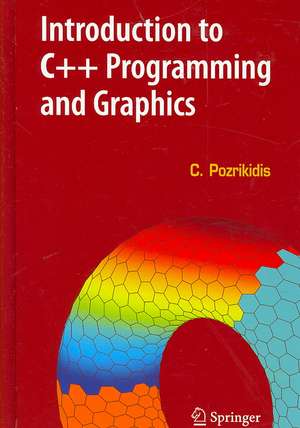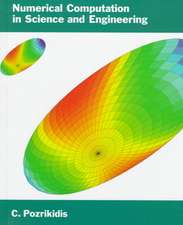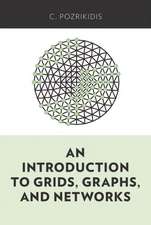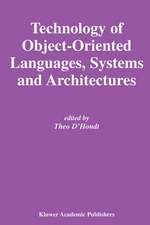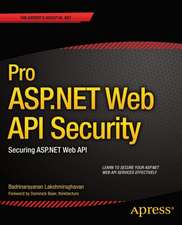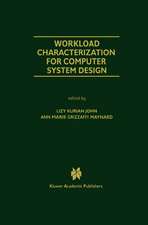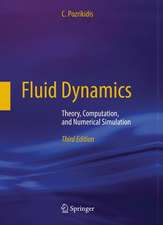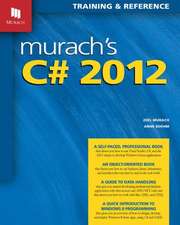Introduction to C++ Programming and Graphics
Autor Constantine Pozrikidisen Limba Engleză Hardback – 6 iun 2007
Introduction to C++ Programming and Graphics offers a venue for rapidly learning the language by concisely revealing its grammar, syntax and main features, and by explaining the key ideas behind object oriented programming (OOP) with emphasis on scientific computing. The book reviews elemental concepts of computers and computing, describes the primary features of C++, illustrates the use of pointers and user-defined functions, analyzes the construction of classes, and discusses graphics programming based on VOGLE and OpenGL.
This essential reference provides a brief introduction to C++ for scientists, engineers, professionals and students already familiar with the general principles of computer programming.
| Toate formatele și edițiile | Preț | Express |
|---|---|---|
| Paperback (1) | 365.33 lei 6-8 săpt. | |
| Springer Us – 4 noi 2010 | 365.33 lei 6-8 săpt. | |
| Hardback (1) | 344.60 lei 6-8 săpt. | |
| Springer Us – 6 iun 2007 | 344.60 lei 6-8 săpt. |
Preț: 344.60 lei
Preț vechi: 430.75 lei
-20% Nou
Puncte Express: 517
Preț estimativ în valută:
65.94€ • 69.03$ • 54.56£
65.94€ • 69.03$ • 54.56£
Carte tipărită la comandă
Livrare economică 05-19 aprilie
Preluare comenzi: 021 569.72.76
Specificații
ISBN-13: 9780387689920
ISBN-10: 0387689923
Pagini: 372
Ilustrații: XII, 372 p.
Dimensiuni: 155 x 235 x 29 mm
Greutate: 0.75 kg
Ediția:2007
Editura: Springer Us
Colecția Springer
Locul publicării:New York, NY, United States
ISBN-10: 0387689923
Pagini: 372
Ilustrații: XII, 372 p.
Dimensiuni: 155 x 235 x 29 mm
Greutate: 0.75 kg
Ediția:2007
Editura: Springer Us
Colecția Springer
Locul publicării:New York, NY, United States
Public țintă
Lower undergraduateCuprins
Computers and Computing.- General Features of C++.- Programming in C++.- User-Defined Functions.- Pointers.- Classes and Objects.- Graphics Programming with VOGLE.- Graphics Programming with GLUT, GLUI, and GTK+.- Using Matlab.
Recenzii
From the reviews:
"This book is a brief and basic introduction to C++ for everyone and especially for scientists and engineers. The text offers a venue for effectively teaching and rapidly learning the language at the level of an undergraduate course in any discipline of the physical sciences and computer science and engineering." (Stefan Meyer, Zentralblatt MATH, Vol. 1128 (6), 2008)
"This book, a relatively small volume of slightly more than 300 pages, covers practically all one needs to know about C++ to be proficient. The concepts and features are introduced with to-the-point illustrating examples. … the book provides an excellent entry point to C++, from which anyone with moderate programming experience will benefit." (Computing Reviews, April, 2008)
"Pozrikidis states that his book is ‘a brief and basic introduction to C++ for everyone and especially for scientists and engineers.’ He follows this with a claim that it ‘offers a venue for effectively teaching and rapidly learning the language at the level of an undergraduate course in any discipline of the physical sciences and computer science and engineering.’" (Thomas Sheehan, ACM Computing Reviews, November, 2008)
"This book is a brief and basic introduction to C++ for everyone and especially for scientists and engineers. The text offers a venue for effectively teaching and rapidly learning the language at the level of an undergraduate course in any discipline of the physical sciences and computer science and engineering." (Stefan Meyer, Zentralblatt MATH, Vol. 1128 (6), 2008)
"This book, a relatively small volume of slightly more than 300 pages, covers practically all one needs to know about C++ to be proficient. The concepts and features are introduced with to-the-point illustrating examples. … the book provides an excellent entry point to C++, from which anyone with moderate programming experience will benefit." (Computing Reviews, April, 2008)
"Pozrikidis states that his book is ‘a brief and basic introduction to C++ for everyone and especially for scientists and engineers.’ He follows this with a claim that it ‘offers a venue for effectively teaching and rapidly learning the language at the level of an undergraduate course in any discipline of the physical sciences and computer science and engineering.’" (Thomas Sheehan, ACM Computing Reviews, November, 2008)
Textul de pe ultima copertă
C++ has grown rapidly in response to the practical need for a programming language that is able to efficiently handle composite and diverse data types. Today, C++ dominates the commercial market and is favored among application developers.
Introduction to C++ Programming and Graphics offers a venue for rapidly learning the language by concisely revealing its grammar, syntax and main features, and by explaining the key ideas behind object oriented programming (OOP), with emphasis on scientific computing.
The book reviews elemental concepts of computers and computing, describes the primary features of C++, illustrates the use of pointers and user-defined functions, and analyzes the construction of classes. Distinctive features include:
Introduction to C++ Programming and Graphics offers a venue for rapidly learning the language by concisely revealing its grammar, syntax and main features, and by explaining the key ideas behind object oriented programming (OOP), with emphasis on scientific computing.
The book reviews elemental concepts of computers and computing, describes the primary features of C++, illustrates the use of pointers and user-defined functions, and analyzes the construction of classes. Distinctive features include:
- An effective selection and presentation of topics and supporting examples
- A tutorial on the usage of MATLAB® functions in C++ code
- Tables for translating MATLAB® and Fortran 77 into C++ code, illustrating syntactic differences between these languages
- Chapters on graphics and GUI programming based on the VOGLE library and the GLUT, GLUI and GTK+ utility toolboxes
Caracteristici
A basic, concise introduction to C++ programming for everyone from students to scientists and engineers seeking a quick grasp of key topics Provides a comparative analysis and discussion of C++ in relation to other programming languages such as C, Fortran, and Matlab® Graphics chapters allow the reader to apply what is taught in the beginning chapters Contains a tutorial on the usage of Matlab® functions in C++ code Includes supplementary material: sn.pub/extras
